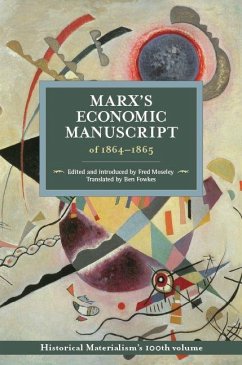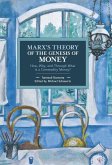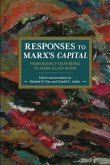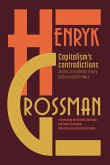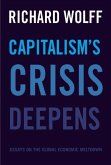Marx's Economic Manuscript of 1864-1865
Herausgeber: Moseley, Fred
Marx's Economic Manuscript of 1864-1865
Herausgeber: Moseley, Fred
- Broschiertes Buch
- Merkliste
- Auf die Merkliste
- Bewerten Bewerten
- Teilen
- Produkt teilen
- Produkterinnerung
- Produkterinnerung
With this volume, Marxist scholars can finally compare Engels's Volume III with Marx's original manuscript and evaluate the differences.
Andere Kunden interessierten sich auch für
![Marx's Theory of the Genesis of Money Marx's Theory of the Genesis of Money]() Samez Kuruma &Marx's Theory of the Genesis of Money33,99 €
Samez Kuruma &Marx's Theory of the Genesis of Money33,99 €![Responses to Marx's Capital Responses to Marx's Capital]() Responses to Marx's Capital75,99 €
Responses to Marx's Capital75,99 €![Modern Imperialism, Monopoly Finance Capital, and Marx's Law of Value Modern Imperialism, Monopoly Finance Capital, and Marx's Law of Value]() Samir AminModern Imperialism, Monopoly Finance Capital, and Marx's Law of Value34,99 €
Samir AminModern Imperialism, Monopoly Finance Capital, and Marx's Law of Value34,99 €![Capitalism's Contradictions Capitalism's Contradictions]() Henryk GrossmanCapitalism's Contradictions21,99 €
Henryk GrossmanCapitalism's Contradictions21,99 €![The Coming Revolution: Capitalism in the 21st Century The Coming Revolution: Capitalism in the 21st Century]() Ben ReynoldsThe Coming Revolution: Capitalism in the 21st Century26,99 €
Ben ReynoldsThe Coming Revolution: Capitalism in the 21st Century26,99 €![Capitalism's Crisis Deepens Capitalism's Crisis Deepens]() Richard D WolffCapitalism's Crisis Deepens17,99 €
Richard D WolffCapitalism's Crisis Deepens17,99 €![Design of a Worker Cooperatives Society Design of a Worker Cooperatives Society]() Geert ReutenDesign of a Worker Cooperatives Society46,99 €
Geert ReutenDesign of a Worker Cooperatives Society46,99 €-
-
-
With this volume, Marxist scholars can finally compare Engels's Volume III with Marx's original manuscript and evaluate the differences.
Hinweis: Dieser Artikel kann nur an eine deutsche Lieferadresse ausgeliefert werden.
Hinweis: Dieser Artikel kann nur an eine deutsche Lieferadresse ausgeliefert werden.
Produktdetails
- Produktdetails
- Verlag: Haymarket Books
- Seitenzahl: 1000
- Erscheinungstermin: 17. Oktober 2017
- Englisch
- Abmessung: 229mm x 152mm x 53mm
- Gewicht: 1089g
- ISBN-13: 9781608466900
- ISBN-10: 1608466906
- Artikelnr.: 44678477
- Herstellerkennzeichnung
- Libri GmbH
- Europaallee 1
- 36244 Bad Hersfeld
- gpsr@libri.de
- Verlag: Haymarket Books
- Seitenzahl: 1000
- Erscheinungstermin: 17. Oktober 2017
- Englisch
- Abmessung: 229mm x 152mm x 53mm
- Gewicht: 1089g
- ISBN-13: 9781608466900
- ISBN-10: 1608466906
- Artikelnr.: 44678477
- Herstellerkennzeichnung
- Libri GmbH
- Europaallee 1
- 36244 Bad Hersfeld
- gpsr@libri.de
Karl Marx was born in 1818. He was the co-author of the Manifesto of the Communist Party. He lived in England as a refugee until his death in 1888, after participating in an unsuccessful revolution in Germany. Fred Moseley is Professor of Economics at Mount Holyoke College (Massachusetts, USA). He is the author of The Falling Rate of Profit in the Postwar United States Economy (1992) and editor of Marx's Logical Method: A Reappraisal (1993), and New Investigations of Marx's Method (1997).
Translator's Note
Introduction by Fred Moseley
Chapter One: The Transformation of Surplus-Value into Profit
1. Surplus-Value and Profit
[2. Cost Price]
3. Economy in the Use of Constant Capital
4. The Effect of Changes in Raw Material Prices
5. Release and Tying-up of Capital, Depreciation and Appreciation,
Revaluation and Devaluation of Capital
6. The Influence of Changes in Circulation Time, its Shortening or
Lengthening (and also changes in the means of communication connected with
this) on the Rate of Profit
7. Profit (as it appears to the bourgeois)
Chapter Two: The Transformation of Profit into Average Profit
1. Different Compositions of Capital in Different Branches of Production
and the Resulting Variation in Rates of Profit
2. Formation of a General Rate of Profit (Average Profit) and
Transformation of Commodity Values into Prices of Production
3. The Equalisation of the General Rate of Profit through Competition.
Market Prices and Market Values. Surplus Profit.
4. The Effects of a General Increase or Reduction (Fall) in Wages on the
Prices of Production of the Different Commodities
5. The Capitalist's Grounds for Compensation Supplement on Prices of
Production
Chapter Three: The Law of the Tendential Fall in the General Rate of Profit
with the Advance of Capitalist Production
Chapter Four: The Transformation of Commodity Capital and Money Capital
into Merchant's Capital (Commodity-Dealing Capital and Money-Dealing
Capital)
1. Commodity-Dealing Capital (Commercial Profit)
2. Commercial Profit and its Characteristics
3. The Turnover of Mercantile Capital. Prices
4. Money-Dealing Capital
5. [no title]
Chapter Five: The Division of Profit into Interest and Profit of
Enterprise. (Industrial or Commercial Profit). Interest-Bearing Capital
1. [Interest-Bearing Capital]
2. Division of Profit. Rate of Interest. The Natural Rate of Interest
3. Interest and Profit of Enterprise
4. The Externalisation of Surplus-Value and the Capital Relation in General
in the Form of Interest-Bearing Capital
5. Credit. Fictitious Capital
6. Pre-Bourgeois Relations
Chapter Six: The Transformation of Surplus Profit into Ground-Rent
(a) Introduction
(c) Absolute Ground-Rent
(b) Differential Rent
[The First Form of Differential Rent]
[The Second Form of Differential Rent]
Chapter Seven: The Revenues and their Sources
1. The Trinity Formula
2. [On the Analysis of the Production Process]
3. The Illusion Created by Competition
4. Relations of Production and Distribution
5. Classes
Appendix
Bibliography
Index
Introduction by Fred Moseley
Chapter One: The Transformation of Surplus-Value into Profit
1. Surplus-Value and Profit
[2. Cost Price]
3. Economy in the Use of Constant Capital
4. The Effect of Changes in Raw Material Prices
5. Release and Tying-up of Capital, Depreciation and Appreciation,
Revaluation and Devaluation of Capital
6. The Influence of Changes in Circulation Time, its Shortening or
Lengthening (and also changes in the means of communication connected with
this) on the Rate of Profit
7. Profit (as it appears to the bourgeois)
Chapter Two: The Transformation of Profit into Average Profit
1. Different Compositions of Capital in Different Branches of Production
and the Resulting Variation in Rates of Profit
2. Formation of a General Rate of Profit (Average Profit) and
Transformation of Commodity Values into Prices of Production
3. The Equalisation of the General Rate of Profit through Competition.
Market Prices and Market Values. Surplus Profit.
4. The Effects of a General Increase or Reduction (Fall) in Wages on the
Prices of Production of the Different Commodities
5. The Capitalist's Grounds for Compensation Supplement on Prices of
Production
Chapter Three: The Law of the Tendential Fall in the General Rate of Profit
with the Advance of Capitalist Production
Chapter Four: The Transformation of Commodity Capital and Money Capital
into Merchant's Capital (Commodity-Dealing Capital and Money-Dealing
Capital)
1. Commodity-Dealing Capital (Commercial Profit)
2. Commercial Profit and its Characteristics
3. The Turnover of Mercantile Capital. Prices
4. Money-Dealing Capital
5. [no title]
Chapter Five: The Division of Profit into Interest and Profit of
Enterprise. (Industrial or Commercial Profit). Interest-Bearing Capital
1. [Interest-Bearing Capital]
2. Division of Profit. Rate of Interest. The Natural Rate of Interest
3. Interest and Profit of Enterprise
4. The Externalisation of Surplus-Value and the Capital Relation in General
in the Form of Interest-Bearing Capital
5. Credit. Fictitious Capital
6. Pre-Bourgeois Relations
Chapter Six: The Transformation of Surplus Profit into Ground-Rent
(a) Introduction
(c) Absolute Ground-Rent
(b) Differential Rent
[The First Form of Differential Rent]
[The Second Form of Differential Rent]
Chapter Seven: The Revenues and their Sources
1. The Trinity Formula
2. [On the Analysis of the Production Process]
3. The Illusion Created by Competition
4. Relations of Production and Distribution
5. Classes
Appendix
Bibliography
Index
Translator's Note
Introduction by Fred Moseley
Chapter One: The Transformation of Surplus-Value into Profit
1. Surplus-Value and Profit
[2. Cost Price]
3. Economy in the Use of Constant Capital
4. The Effect of Changes in Raw Material Prices
5. Release and Tying-up of Capital, Depreciation and Appreciation,
Revaluation and Devaluation of Capital
6. The Influence of Changes in Circulation Time, its Shortening or
Lengthening (and also changes in the means of communication connected with
this) on the Rate of Profit
7. Profit (as it appears to the bourgeois)
Chapter Two: The Transformation of Profit into Average Profit
1. Different Compositions of Capital in Different Branches of Production
and the Resulting Variation in Rates of Profit
2. Formation of a General Rate of Profit (Average Profit) and
Transformation of Commodity Values into Prices of Production
3. The Equalisation of the General Rate of Profit through Competition.
Market Prices and Market Values. Surplus Profit.
4. The Effects of a General Increase or Reduction (Fall) in Wages on the
Prices of Production of the Different Commodities
5. The Capitalist's Grounds for Compensation Supplement on Prices of
Production
Chapter Three: The Law of the Tendential Fall in the General Rate of Profit
with the Advance of Capitalist Production
Chapter Four: The Transformation of Commodity Capital and Money Capital
into Merchant's Capital (Commodity-Dealing Capital and Money-Dealing
Capital)
1. Commodity-Dealing Capital (Commercial Profit)
2. Commercial Profit and its Characteristics
3. The Turnover of Mercantile Capital. Prices
4. Money-Dealing Capital
5. [no title]
Chapter Five: The Division of Profit into Interest and Profit of
Enterprise. (Industrial or Commercial Profit). Interest-Bearing Capital
1. [Interest-Bearing Capital]
2. Division of Profit. Rate of Interest. The Natural Rate of Interest
3. Interest and Profit of Enterprise
4. The Externalisation of Surplus-Value and the Capital Relation in General
in the Form of Interest-Bearing Capital
5. Credit. Fictitious Capital
6. Pre-Bourgeois Relations
Chapter Six: The Transformation of Surplus Profit into Ground-Rent
(a) Introduction
(c) Absolute Ground-Rent
(b) Differential Rent
[The First Form of Differential Rent]
[The Second Form of Differential Rent]
Chapter Seven: The Revenues and their Sources
1. The Trinity Formula
2. [On the Analysis of the Production Process]
3. The Illusion Created by Competition
4. Relations of Production and Distribution
5. Classes
Appendix
Bibliography
Index
Introduction by Fred Moseley
Chapter One: The Transformation of Surplus-Value into Profit
1. Surplus-Value and Profit
[2. Cost Price]
3. Economy in the Use of Constant Capital
4. The Effect of Changes in Raw Material Prices
5. Release and Tying-up of Capital, Depreciation and Appreciation,
Revaluation and Devaluation of Capital
6. The Influence of Changes in Circulation Time, its Shortening or
Lengthening (and also changes in the means of communication connected with
this) on the Rate of Profit
7. Profit (as it appears to the bourgeois)
Chapter Two: The Transformation of Profit into Average Profit
1. Different Compositions of Capital in Different Branches of Production
and the Resulting Variation in Rates of Profit
2. Formation of a General Rate of Profit (Average Profit) and
Transformation of Commodity Values into Prices of Production
3. The Equalisation of the General Rate of Profit through Competition.
Market Prices and Market Values. Surplus Profit.
4. The Effects of a General Increase or Reduction (Fall) in Wages on the
Prices of Production of the Different Commodities
5. The Capitalist's Grounds for Compensation Supplement on Prices of
Production
Chapter Three: The Law of the Tendential Fall in the General Rate of Profit
with the Advance of Capitalist Production
Chapter Four: The Transformation of Commodity Capital and Money Capital
into Merchant's Capital (Commodity-Dealing Capital and Money-Dealing
Capital)
1. Commodity-Dealing Capital (Commercial Profit)
2. Commercial Profit and its Characteristics
3. The Turnover of Mercantile Capital. Prices
4. Money-Dealing Capital
5. [no title]
Chapter Five: The Division of Profit into Interest and Profit of
Enterprise. (Industrial or Commercial Profit). Interest-Bearing Capital
1. [Interest-Bearing Capital]
2. Division of Profit. Rate of Interest. The Natural Rate of Interest
3. Interest and Profit of Enterprise
4. The Externalisation of Surplus-Value and the Capital Relation in General
in the Form of Interest-Bearing Capital
5. Credit. Fictitious Capital
6. Pre-Bourgeois Relations
Chapter Six: The Transformation of Surplus Profit into Ground-Rent
(a) Introduction
(c) Absolute Ground-Rent
(b) Differential Rent
[The First Form of Differential Rent]
[The Second Form of Differential Rent]
Chapter Seven: The Revenues and their Sources
1. The Trinity Formula
2. [On the Analysis of the Production Process]
3. The Illusion Created by Competition
4. Relations of Production and Distribution
5. Classes
Appendix
Bibliography
Index

